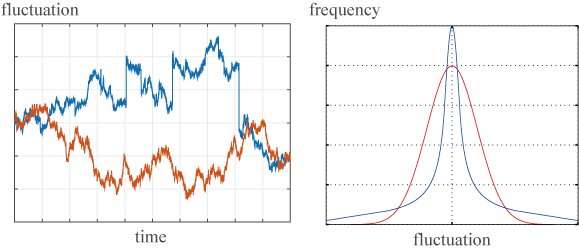Evaluation method for the impact of wind power fluctuation on power system quality

Abrupt changes of wind power generation output are a source of severe damage to power systems. Researchers at Kyoto University developed a stochastic modeling method that enables to evaluate the impact of such phenomena. The feature of the method lies in its significant computational effectiveness in comparison to standard Monte Carlo simulation, and its applicability to analysis and synthesis of various systems subject to extremum outliers.
Introduction of wind power generation into the electric power system is proceeding actively, mainly in the United States and Europe, and is expected to continue in Japan. However, upon the implementation, it is crucial to deal with prediction uncertainty of output fluctuation. The fluctuation of wind power generation is usually small, but it becomes extremely large due to the occurrence of gusts and turbulence at a non-negligible frequency. Such extreme outliers have been regarded as a source of severe damage to power systems.
To cope with such a fluctuation of wind power generation, the goal setting such as "absolutely keep the frequency fluctuation within 0.2 Hz" would be unattainable or would result in an overly conservative design. Therefore, the probabilistic goal setting such as "keep the frequency fluctuation within 0.2 Hz with 99.7 percent or more" is indispensable.
Probabilistic uncertainty is evaluated statistically, commonly by assuming that it obeys normal distribution for its mathematical processability. The output outliers in wind power generation are, however, more frequent than represented by normal distribution. Even if a complicated simulator can be constructed without assuming normal distribution, it is not realistic to investigate the statistical property by Monte Carlo simulation. This is because the required number of samples explodes before sufficiently many extreme outliers occur.
An evaluation method was developed for the impact of wind power fluctuation on power system quality. The method first builds probabilistic models assuming the stable distribution (an extension of the normal distribution) on the uncertainty. Then, instead of using the model as a simulator to generate data samples, we compute the statistical properties directly from parameters in the model. The important feature is 1. the influence of extreme outliers can be properly considered, 2. model can be determined easily from actual data, and 3. computation cost is very low. The method was proved to be valid through its application to frequency deviation estimation based on actual power system data.
This newly proposed probabilistic evaluation method enables us to quantitatively evaluate the power system risk caused by the occurrence of extremally abrupt changes of wind power generation. Countermeasures based on the evaluation would contribute to improvement of the reliability and economic efficiency of the electric power system. It should be also noted that the proposed method is applicable to analysis and synthesis of various systems which have extreme outliers.
More information: Kenji Kashima et al. Stable Process Approach to Analysis of Systems under Heavy-tailed Noise: Modeling and Stochastic Linearization, IEEE Transactions on Automatic Control (2018). DOI: 10.1109/TAC.2018.2842145
Journal information: IEEE Transactions on Automatic Control
Provided by Japan Science and Technology Agency


















